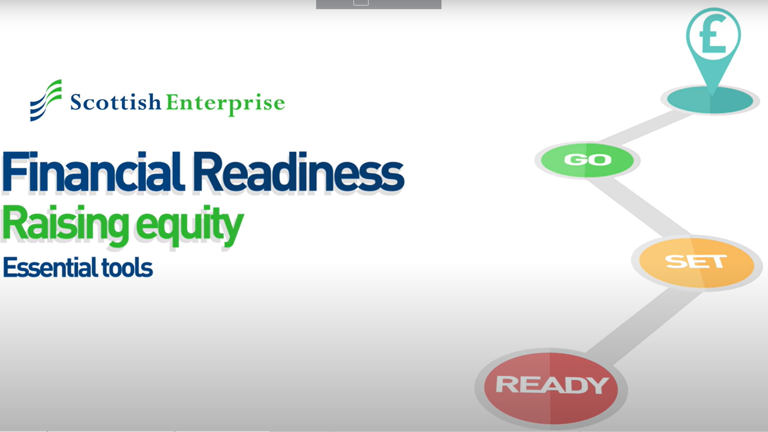Using your business plan to raise finance
This guide summarises what sections to include when preparing a business plan for raising finance.
Set out your business plan
What do you need to secure equity funding?
From the right business plan to selling the opportunity, watch our video with our finance expert, Laurence Jamieson, as he talks you through the process of raising equity investment.

It's so important to have a well-prepared business plan when you're looking to raise finance.
A business plan helps to sell the opportunity to invest in your business to potential funders. Therefore, it's crucial to have a compact and realistic plan that clearly communicates your company’s objectives, financial performance and strategy.
Your business plan should include the following sections:
Executive summary
Most funders will receive a large number of business plans from businesses so it's important that your plan stands out from the crowd. A well-written executive summary is usually no more than four pages long. The goal is to encourage your potential funder to learn more about the opportunity to invest in your company.
The summary should include:
- Concise overviews of the main sections of the plan
- The business background and objectives
- Products and services
- Customers
- Operations
- Management
- Financial forecasts
- What funding you need
If a funder is unable to understand your business and its competitive advantages within a few pages, it is unlikely they will read the rest of the plan.
Business background
This section should give background information on your business, including current ownership and management and future plans and objectives.
This section is factual so it should be short. It should give the potential funder a sense of how your business has progressed with evidence of financial success.
Products and markets
The products and markets section should give an overview of your products and/or services. It should convince a funder that your business has a substantial and lasting market.
Include detailed descriptions of all revenue streams. It's important to focus on any unique features of your product or service, comparing it with what is currently available on the market.
It's useful to spell out why customers will choose your product or service over your competitors'. A common mistake is not commenting on competitors.
Mention any patents and trademarks. It's also a good idea to talk about potential product expansion opportunities.
Potential funders may not be familiar with your business industry or sector, so you should include an overview of your markets and customers. Show that there is a real demand for your product or service.
At the end of this section, outline your company’s sales strategy. This should validate sales projections within your company’s financial forecasts.
Typical areas to cover include:
- Marketing strategy
- Pricing
- The sales process
- Route to market
- Advertising channels used
- The method of distributing the product/service to customers
Operations
The operations section describes how your company makes and prepares your product or service.
As a minimum, you should cover the following areas:
- Labour
- Materials
- Facilities
- Equipment and processes
By covering only the main details in each category, you would deal with initial questions without overwhelming potential funders with details.
Emphasise any patented technologies that give your business a competitive edge and highlight any other key advantages. You want to show your business can deliver its product or service to market while priced at a level that is enough to make an acceptable profit.
Potential funders will be interested in your business' facilities. Therefore give location details and the size of main operating units, and whether these are owned or leased.
If your company’s activities are reliant on key assets, provide their details, including a description of their function and age.
Management and employees
Management and employees can significantly influence a funder’s decision of whether or not to support a business. Show that you have a team, which has the necessary blend of technical, commercial and managerial experience.
Funders will look for the following core elements:
- If the team have the required skillset
- Their prior industry experience
- The personality fit of the team and their collective complementary skillset
- Evidence of a shared vision
- Their overall commitment
This section of the business plan should provide details of all key management personnel within the business, including their roles and areas of responsibility.
It should also give information on their skills and experience, plus details of the workforce.
Depending on the business size and its management structure, an organisation chart might be useful.
Financial summary and why you need funding
The financial summary should give a short evaluation of the financial performance of your company.
Funders need to be convinced that their risk in funding your business is at an acceptable level. One of their key measures will be the level of potential financial risk.
Therefore it's important that the financial information you give is realistic and would stand up to rigorous scrutiny.
Being able to quantify and justify your funding requirements is very important. The best way to do this is by preparing a detailed financial model.
As a minimum, include a profit and loss account, cash flow and balance sheet, ideally for a three-year forecast period, with commentary on key assumptions and outputs.
Helping potential funders make an informed decision
Remember that funders see a huge number of business plans and are very selective of what they will fund.
By making sure your business plan provides all the necessary information to help funders make an informed decision, you're giving yourself the best chance possible of getting funding.
Got a question about accessing finance?
Get in touch with our team of experienced financial readiness experts who can help you secure funding from a range of sources, including bank funding, equity funding, and grants.
-
Sign up to email updates
Subscribe to our newsletter to hear about new business guides, case studies, events and industry updates.
